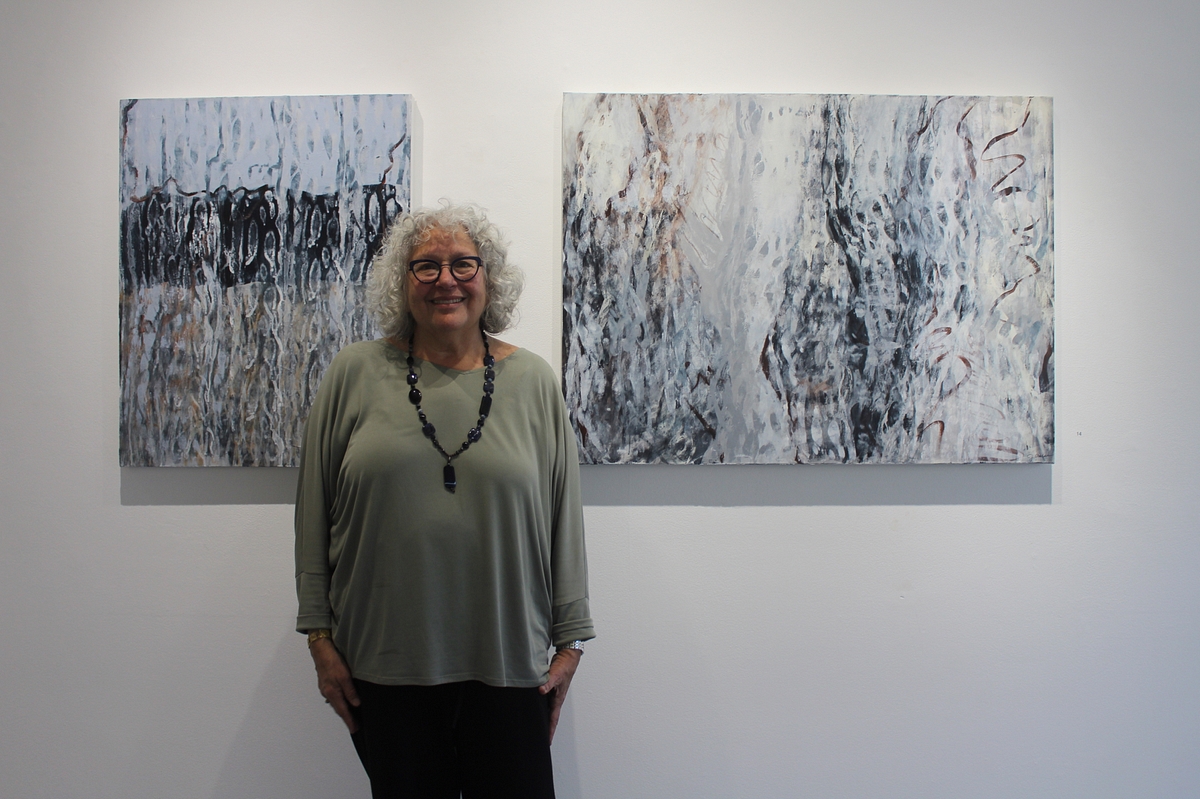
The layers of overlapping textures, patterns, and colors are, in truth, abstract. But they evoke much of what we see in our lives. Maybe it’s a picture in a magazine of the surface of an insect leg, magnified a thousand times. Maybe it’s a close up of fabric, or water running down a window. For the painter, Judy Atlas, the connection between the painting and the world is the viewer’s to make. For Atlas herself, the connections between the paintings tell their own story, too.
The pieces are in “Abstractions … Naturally,” a show of work by Judy Atlas at City Gallery on Upper State Street running now through Nov. 27. The paintings in the show are all inspired by forms and colors in the world. “I take many photos of nature, and I use them to find a way to abstract from what I see,” she explains in an accompanying statement. “The process includes asking myself ‘what if’ questions like: What if I take a small piece of the pattern and blow it up? What if I add different shapes to the pattern? What if I change the color, make the painting bigger, or smaller?… Those questions allow for a different way of seeing things — a new perspective, or a series of them, one inspired by the next. The result, and this exhibit, is a fluid and natural interpretation of the world around us.”
“What do you see when you spend time in nature…the trees? the clouds? sunlight on water? the
path ahead?” she asks the viewer in an accompanying statement.
But the paintings are also a trip through time, as Atlas found that one painting led naturally to the creation of another. “When I used to teach, I would ask my students to do a series, and you ask questions of yourself. What if I try it this way? What if I try it that way? What if I make it big, or small, or green, or purple? So that’s what a lot of these paintings are,” she said.
For Atlas, the impetus for the series of paintings came from visits to botanical gardens with her husband; she was drawn to the patterns she saw there. It was partly about that, and “partly about process,” she said. “I was very intrigued by the mark making and the layering of marks.” She realized that the first marks she made “elicit to the viewer all sorts of thoughts about where they are and what they see in them.” She heard many different responses, from forests to feathers to running water. What they all had in common was suggesting nature.

Flux in Nature.
She did a few more pieces in that style and then thought “I need to vary it up a bit,” she said. “I love geometrics, so I started containing these marks,” creating overall quilt-like patterns that also allowed for greater variety within the paintings.

Patchwork.
This resulted in the busiest canvases in the show. “Then I quieted it down,” she said, and did the next few paintings. “So they all ended relating to each other, which I found a wonderful process.” From the quilt-like canvas came others that were like puzzle pieces. Others used geometric shapes.
Then, Atlas thought, “I need to break away from this for a little bit.” She “started sliding paint around and working in movement that doesn’t end consciously, creating flux, creating something that doesn’t have a beginning or an end. And I kept on trying,” creating cohesion through layering, the repetition of patterns and lines.

Mystery.
A vacation in Portugal while Atlas was in the middle of the series yielded further inspiration, from patterns of rock and bark she saw there, which she abstracted into its basic forms and worked with from there.
That move, from the world onto the canvas, is part of Atlas’s general approach to painting. “So much of what I see, I do without even thinking of it,” she said. Or something she sees in the present will remind her of something she saw years ago, and she paints from there. “It’s just part of the natural world that we take for granted.”
At first glance, what Atlas has done in this series of paintings can be seen as fundamentally different from abstractions that begin with a blank canvas, no figures from photographs or memories to guide the composition. “I have painted abstractly, where I was just angry and made a black canvas, or I had to get something out,” Atlas said.
“There are different ways to abstract. Sometimes you’re very influenced by your history, what you see. And then other times you just go for. And then it becomes color. What makes up paintings? Color, lines, shape, form, and how you organize them.” In a larger sense, all painting that deviates from photorealism is an abstraction of some kind. “Unless it’s photojournalism, you are changing what you see to make it fit in your frame. Like when you take a photograph. How does it fit in the frame? Where do you place what you want people to look at, and how do you compose it?”
But the paintings in the City Gallery show were “a different project for me.… I’ve imposed my own ideas, colors, composition. I’ve taken them to make it my own,” Atlas said. “It was a learning experience for me, and I felt like I brought a lot of my ideas together.”